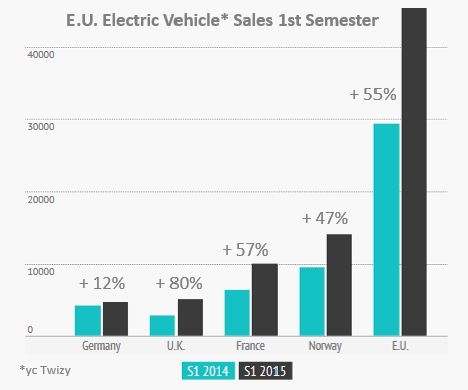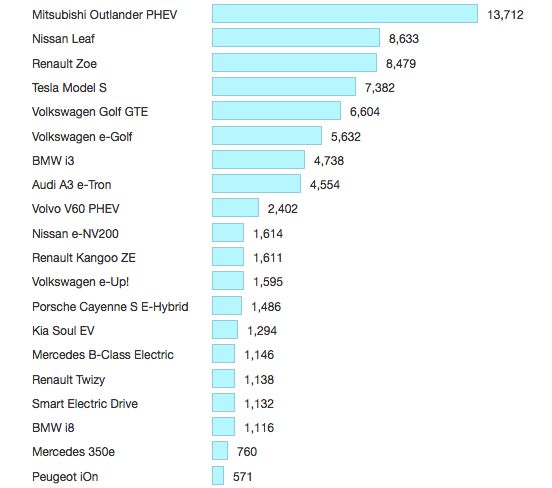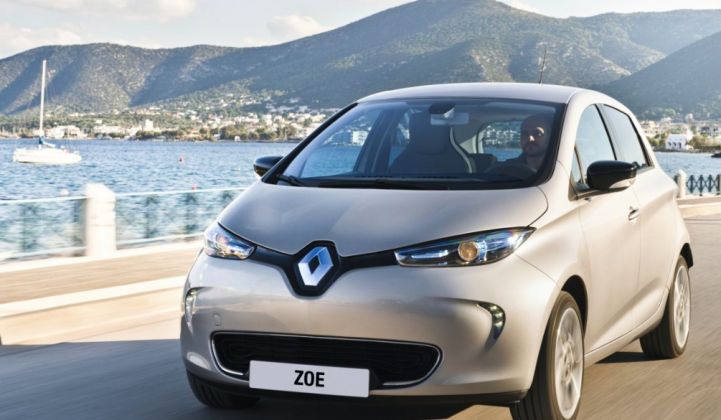Electric vehicle sales have been growing steadily in Europe, while sales have faltered in the U.S.
According to Renault Z.E., which tracks electric vehicle sales across Europe, all-electric vehicle sales in the region rose 55 percent in the first half of 2015 compared to the first six months of 2014.
The United Kingdom saw the biggest increase, with sales up 80 percent, amounting to roughly 5,000 units sold. Norway still leads the region in overall numbers, however, with sales up 47 percent, reaching around 15,000 EVs sold in the first half of the year.

Source: Renault Z.E.
When counting both battery-electric vehicles (BEVs) and plug-in hybrid vehicles (PHEVs), European EV sales look even stronger. Between January and April 2015, consumers in Western Europe alone purchased 51,386 plug-in cars, according to the European Automotive Industry Data newsletter.
BEVs saw greater uptake, with 26,808 units sold through April, versus 24,578 PHEVs.
These sales mean that Western European countries have 60 percent more electric cars than the U.S., Hybrid Cars reports. Americans bought 32,087 plug-in EVs through April -- comprising 21,403 BEVs and 10,684 PHEVs.
This marks the first time the EU (which is more or less a cohesive sales region) has led the global EV market. Last year, the U.S. sold just over 118,000 EVs, versus nearly 98,000 EVs sold in the EU. Sales in China last year totaled 74,763 units, according to the China Association of Automobile Manufacturers.
It’s also interesting to note that U.S. EV sales have traditionally been more evenly split between vehicle types. From January 2014 to April 2014, there were 15,967 PHEVs and 15,060 BEVs sold, versus the 10,684 PHEVs and 21,403 BEVs sold over the same period in 2015.
One reason PHEVs are lagging could be because U.S. consumers are waiting for the 2016 Chevrolet Volt, which will have several improvements over its predecessor, including a 50-mile electric driving range, a nicer interior and a lower price. Pent-up demand for the 2016 Volt could also be a reason why the U.S. is trailing the EU this year. But there are likely other reasons, as well.
For one thing, European drivers still pay much more for fuel than do drivers in the U.S., making gasoline-free cars more attractive. Due to plummeting oil prices, regular gasoline in the U.S. currently averages around $2.60 a gallon, compared with $3.50 a year ago. Meanwhile, the U.K. and Norway are still paying $6.77 and $7.00 for gasoline, respectively, on a per-gallon equivalent.
Another reason the U.S. is trailing could be that there are more EV models available in Europe than there are in America. That includes models like the popular Mitsubishi Outlander PHEV, as well as cars from Citroen, Peugeot and Renault.
According to figures collected by the website EV Obsession, the Outlander is leading the European market so far this year*. The Renault Zoe all-electric compact car had the best sales in June. The U.S. market could regain some ground as new models hit the showrooms -- at least that's what automakers and environmentalists hope.
Figure: Year-to-Date European EV Sales

See EV Obsession for the full list.
*An earlier version of this article incorrectly stated that the Renault Zoe was the best-selling EV in Europe YTD. The Zoe was the best-selling EV in June. The chart above has been updated to reflect YTD sales.



